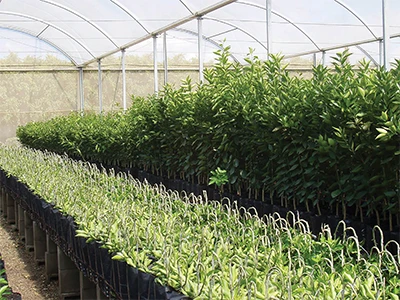
 Growers are continually looking for the holy grail of soilless potting mixes. Such a mix would be economical, easy to handle, porous but able to retain the right amount of moisture, hold nutrients, and of course, improve crop performance and yield. Wishful thinkers would also look for a mix that would contribute to disease and pest control and resistance.
Growers are continually looking for the holy grail of soilless potting mixes. Such a mix would be economical, easy to handle, porous but able to retain the right amount of moisture, hold nutrients, and of course, improve crop performance and yield. Wishful thinkers would also look for a mix that would contribute to disease and pest control and resistance.
While such perfection isn’t available in a single product, here are three ingredients that could enhance your growing results.
Silicon
Industry research shows adding silicon to growing mixes improves the overall health of plants, prompting the American Plant Food Control Officials to look at silicon in “a new way” and endorse it as a beneficial substance.
While silicon is naturally found in soil, substrates for greenhouse production have gradually shifted from field soil to entirely soilless media. And while plants grown in traditional growing mixes containing peat moss, vermiculite, and perlite appear fine, plants benefit from silicon – absorbing the substance to be structurally and biochemically sound, according to Sun Gro researcher, Dr. Shiv Reddy.
Reddy says plants use silicon to protect against nature’s vagaries, i.e., pest attacks, drought, toxic elements, and strong winds. In other words, he says, silicon is able to improve the overall vigor of plants through its ability to protect what nature throws its way, much like fluoride protects against tooth decay caused by plaque bacteria and too much sugar.
When plants take up silicon in nature, silicic acid is deposited in the roots and some in the xylem in the shoot. After it reaches the leaves the silicic acid is deposited in the walls of epidermal cells, just beneath the cuticle. Along the way some silicon is deposited in the roots and xylem in the shoot of the plant. Silicic acid is eventually deposited in the walls of epidermal cells, just beneath the cuticle. And here is the kicker and why growers should care about silicon: as transpiration occurs and water is lost, silicic acid concentrates and polymerizes to a solid silica gel. This results in the formation of a double layer of cuticle-silicon. The solid silica gel bodies are called phytoliths or plant opals, as they give toughness to plant tissues.
Research also has shown silicon protects against pathogens that cause foliar diseases, such as blasts, blight, powdery mildews, leaf spots, ruts, Botrytis and stem rots and root diseases, including Pythium and Phytophthora. And it guards against pests such as stem borers, hoppers, leaf miners, aphids, thrips, spiders, and mites.
Mycorrhizal fungi
When added to a traditional peat-based growing media, Mycorrhizal fungi has been touted as a natural way to improve the overall growth and hardiness of bedding plants and ornamentals. This naturally occurring organism forms a symbiotic relationship with plant roots.
Ninety percent of plants in nature form this mutually beneficial relationship. The fungal filaments that colonize around the roots of plants will help the plant absorb more water as well as nutrients, such as phosphorus, zinc, and copper. This process naturally enhances the growth and rapid development of roots, as well as the plant itself.
In addition, mycorrhizae helps plants resist stress. And stress-free plants don’t attract diseases or pests as readily as weaker plants, according to Martin Trepanier, researcher at the University Laval-Pavillon Environtron.
In broccoli, green pepper, and tomato tests, organic growing mixes containing mycorrhizal fungi outperformed an organic medium that did not contain mycorrhizal fungi.
Plants were grown in a greenhouse and in the field. Broccoli showed increases in top and root dry weight, plants were greener, and stem diameter was greater. Green pepper plants were also greener with greater stem diameters and shorter internodes. Tomato showed a 53.2 percent increase in shoot dry weight, greener plants, and better rooting.
Other results:
- Boston fern, 50 percent more cuttings
- Asparagus, 67 percent more yield, greater number of ferns
- Carrots, 14 percent more yield
- Leek, 20 percent greater fresh weight (diameter)
- Onion, 29 percent larger bulb
- Pepper, 28 percent more fruit
- Strawberry, 23 percent more daughters palnts (Veestar)
- Geranium 25 percent more cuttings, earlier flowering
- Coleus, 28 percent greater branching
Pine bark substrates
Geographic location will largely determine the cost and availability of growing media (peat-based or otherwise), such as coir. Other factors also help determine these costs, including current government rules and regulations, occasional shortages, fluctuations in costs of other components in the mix, such as perlite, and variables that affect the product itself, such as processing and storage.
 Public perception also plays a role, particularly with people concerned about how “green” a growing media really is in terms of sustainability of harvest.
Public perception also plays a role, particularly with people concerned about how “green” a growing media really is in terms of sustainability of harvest.
It’s these variables that are driving researchers, such as Brian E. Jackson, from North Carolina State University, to constantly test and experiment with products that can be used in a growing media that can be used as alternatives or supplements when needed.
Jackson says there is a lot of interest being shown in wood substrates these days, as a possible alternative and/or additive to a grow mix. One example of a wood substrate that is in the testing phase is pine wood chips (PWC) acquired from loblolly pine (Pinus taeda). Research has been done at NCSU with PWC to determine if it is a suitable replacement for perlite, which at times can fluctuate in price and availability.
Jackson and other researchers at NCSU found that when PWC was amended with peat at ratios of 10, 20, or 30 percent by volume, compared to the same ratios of perlite, no differences were seen in physical properties (air and water holding capacity), fertility requirements, PGR rates/efficacy, susceptibility to diseases– particularly Pythium sp. and Rhizoctonia sp.– and shrinkage or decomposition.
They concluded that based on the results of their testing, no cultural changes in crop production are needed to switch from perlite to PWC.
The use of pine wood chips should be economically feasible for manufacturers to produce and growers to purchase. According to the study, PWC is available in many local markets in the South and is economical to produce; it is estimated that the combined cost of trees, equipment to process the trees, and the manufacturing, i.e., energy used, man hours, etc., will be 50 percent cheaper than perlite.
Pine bark substrates (PBS) have been trialed, again, most notably at NCSU. Several conclusions have been reached from these trials. To summarize these trials, researchers found PBS do as well and sometimes better than peat-based products when it comes to plant health, growth, and root development.
The objective of testing more products for growing mixes is not to replace peat, but to have locally sourced material that can be available when prices and availability for any growing media fluctuate. Peat is an abundant resource with approximately 270 million acres in Canada alone, of which only a small portion is being harvested in an environmentally friendly way.
With that said, there are several alternatives or extenders that can be used like peat or in conjunction with peat. Pine bark and pine wood substrates may just fit the bill.
FOR MORE on . . .
- silicon, www.sungro.com
- mycorrhizal fungi, www.pthorticulture.com and www.mycorrhizae.com/
- pine bark, http://bit.ly/1shQGHH
Neil Moran is a horticulturist and freelance writer in Sault Ste. Marie, Mich.

Explore the September 2014 Issue
Check out more from this issue and find your next story to read.
Latest from Greenhouse Management
- Anthura acquires Bromelia assets from Corn. Bak in Netherlands
- Top 10 stories for National Poinsettia Day
- Langendoen Mechanical hosts open house to showcase new greenhouse build
- Conor Foy joins EHR's national sales team
- Pantone announces its 2026 Color of the Year
- Syngenta granted federal registration for Trefinti nematicide/fungicide in ornamental market
- A legacy of influence
- HILA 2025 video highlights: John Gaydos of Proven Winners





